Navigating the complexities of email localization presents clear challenges: time-consuming processes, high costs, and the risk of improper localization that fails to resonate with diverse audiences. This article examines how generative AI (GenAI) is revolutionizing email marketing by addressing these issues head-on. Through practical examples and tested solutions, we will show you how GenAI not only streamlines translation and proofreading but also ensures that content is culturally and contextually relevant, making every email campaign more efficient and impactful.
When is GenAI useful for email localization?
In our eBook on effective multilingual email marketing, we mentioned that personalization lies at the heart of effective email marketing. This concept entails delivering the right message to the right person at the right time, also known as the 3R rule. The components of a right message are as follows:
- right context;
- right data;
- right language.
Localization encompasses the “right language” and, partially, the “right context.” This means that it helps create a message that is appropriate and relevant to the specific audience, addressing their circumstances, needs, and cultural backgrounds, all in their preferred language.
When exactly should you turn to GenAI to make your life easier? When is it even possible?
- Understanding the customs and traditions of your global audience: GenAI helps you remember facts, such as how Friday the 13th is considered unlucky in most parts of the world, but in Italy, it is Friday the 17th. This means that you should not send your “scary” Friday the 13th emails to your Italian contacts. Similarly, we suggest that you avoid talking about chips to both your UK and US customers in one email, as they will have different images of “chips” in their heads.
- Tailoring personalized content for different global audiences: Customers' preferences, weather conditions, geographical locations, and many other factors may affect your offer. Thus, knowing these factors and tailoring your content to this information is important. GenAI can then highlight these factors.
- Translations and proofreading: GenAI can translate emails into multiple languages of your choice and proofread your content.
- Email content optimization: First, we should adhere to a selected tone of voice across all email campaigns. Second, we should not only optimize copy for different languages, such as English or French but also tailor it to match the age, location, or industry of our subscribers. For instance, do you know that people in the United States generally prefer an informal tone, whereas in France, a formal tone is often favored?
- Ensuring that your email campaign delivers the intended message: Vague or confusing messages can lead to misunderstandings or misinterpretations, potentially harming customer relationships. Owing to professional deformation, you or your colleagues might not spot descriptions, which can cause misunderstandings. Thus, we suggest that you validate your copy message with GenAI.
- Verifying customers' names for correctly addressing emails in any language: Typos are common, and you do not want to address someone by the wrong name. Moreover, people might provide humorous or fictitious names, and you would not want to call someone in an email, “Mrs. Fiona Charming” (a nod to Shrek 2; this is a real case, by the way).
These are the cases when I turn to GenAI for email localization. If you know of any other ways to use GenAI for email localization and have tried them, please share them in the comments. I will be happy to explore them.
Real-life cases of how GenAI helps with email localization
Hmm, indeed. Why exactly are you supposed to change your steady workflows and integrate GenAI into some processes?
Let me share some real examples for each application individually:
1. Understanding the customs and traditions of your global audience
I want to share two examples here.
Example 1: Cultural differences in terms of holidays
In October 2023, I was planning to update an article dedicated to Friday the 13th. I decided to find out if it is a globally recognized holiday or celebrated differently in various countries.
Naturally, I went to a browser to query, “Is Friday the 13th a global scariest day?” I then turned to ChatGPT and Google's Gemini, full of expectations that they might fail to give me answers.
Here is what they showed me:
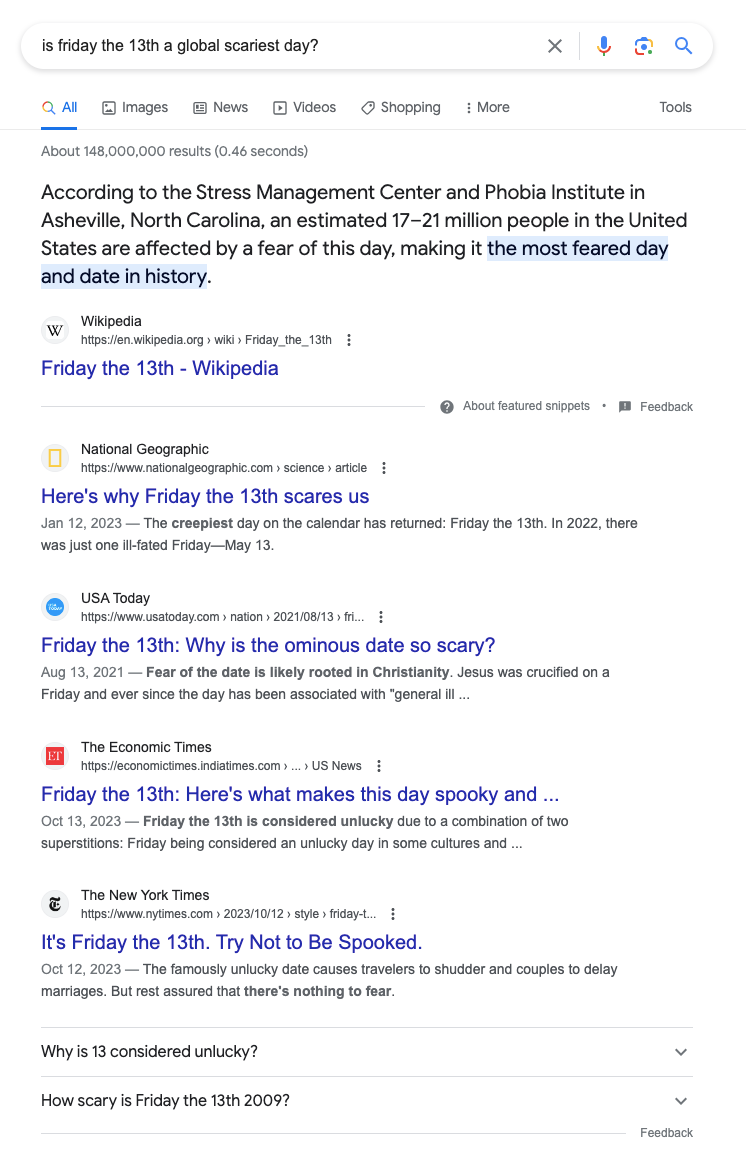
(Source: Google Browser)
The browser explained why this day is considered the scariest holiday of all and even offered tips on how not to get spooked. But I needed to check from country to country if Friday the 13th was spooky — like “Is Friday the 13th considered a scary day in Spain?” and then the same for France, Italy, and so on.
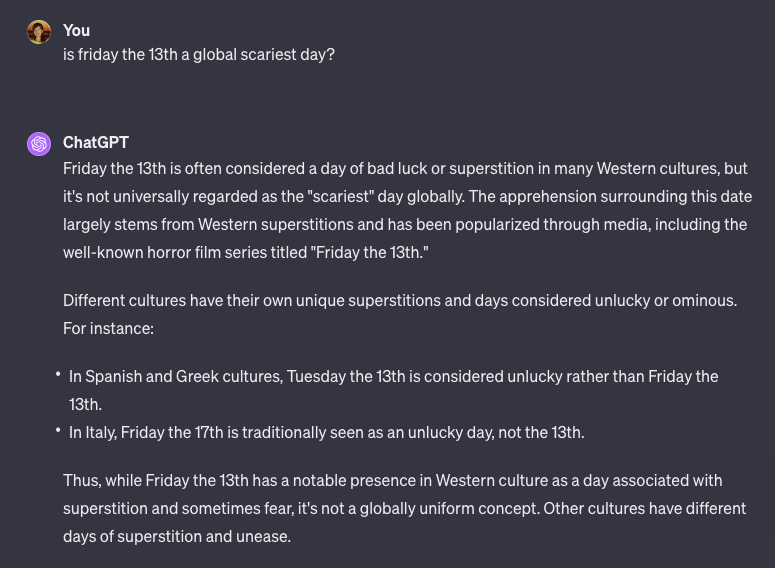
(Source: ChatGPT)
ChatGPT answered my question right away, suggesting that many countries have their own “scariest” days, and provided some examples. It concluded with, “Other cultures have different days of superstition and unease.” So, logically, I asked for more information on these differences.
Here’s what it showed me:
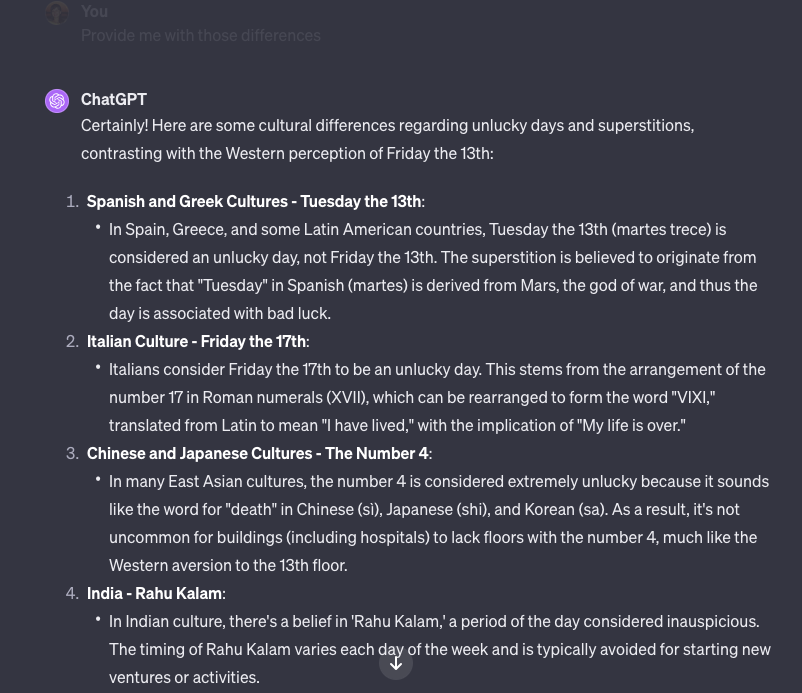
(Source: ChatGPT)
ChatGPT not only explained holidays to me in different countries but also revealed that Chinese and Japanese people are afraid of the number “4.”
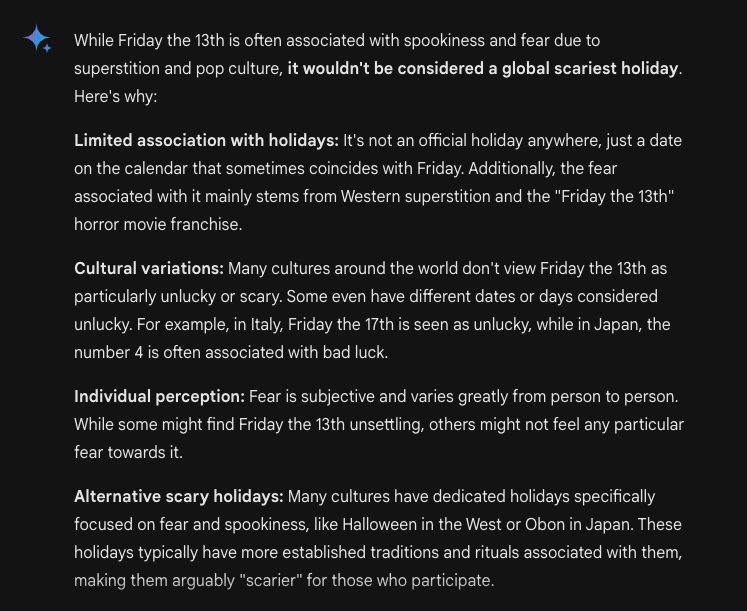
(Source: Google's Gemini)
In one iteration, Gemini informed me that Friday the 13th is the scariest holiday for some Western countries, whereas Friday the 17th was the scariest for Italy. On its own, it also mentioned that the number 4 is considered scary and unlucky in Japan.
I think it does not matter how many iterations were there, one or two; it is still time effective.
Example 2. Searching for funny facts about cultural differences
Remember the fact about chips at the beginning of this article? I learned it from ChatGPT.
A bit of background: I asked Google, ChatGPT, and Gemini for a funny fact about the cultural differences between some English-speaking countries that I should consider when writing an email for all English-speaking contacts.
Here’s what browser and ChatGPT told me:
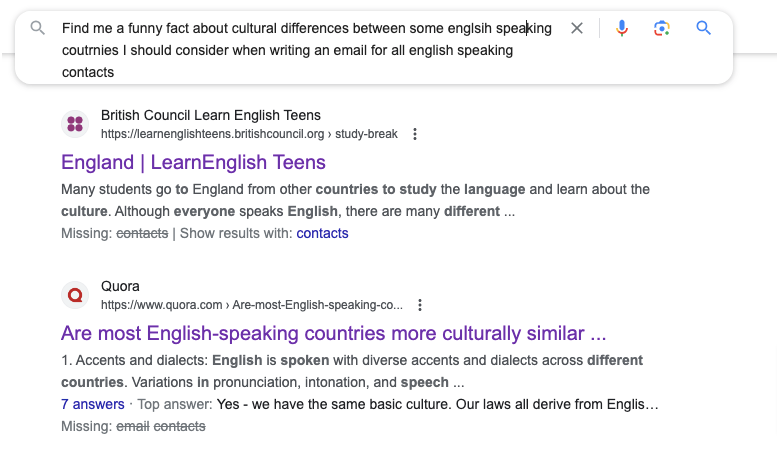
(Source: Google Browser)
My browser showed me learning courses for studying British or American English, and provided a chat thread on Quora where people discussed the differences between British and American English.
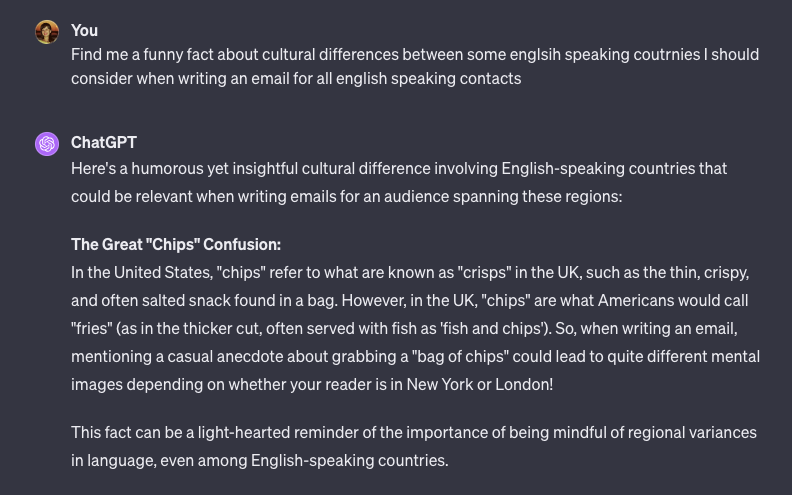
(Source: ChatGPT)
On the other hand, ChatGPT provided information about fries and crisps.
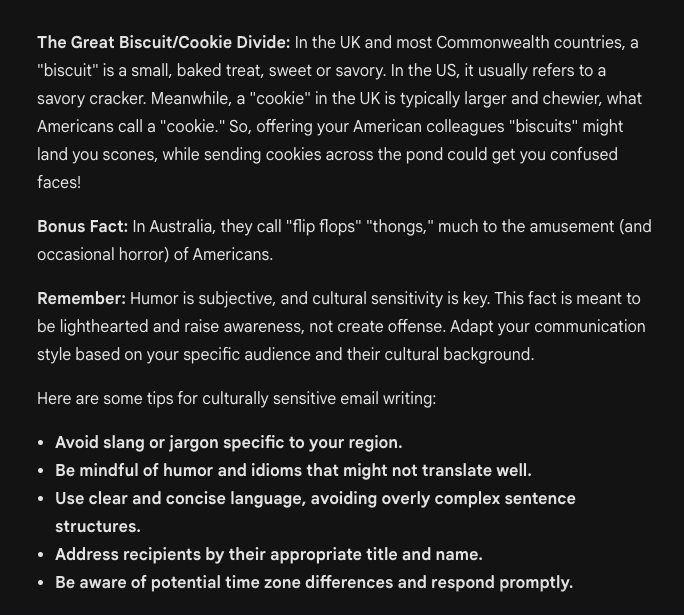
(Source: Google's Gemini)
Gemini clued me in on some quirky language differences: in the United States, what we call “flip-flops” are known as “thongs” in Australia, which could lead to some awkward mix-ups because “thongs” in the United States means something entirely different. There is more! “Cookies” in the United States are often called “biscuits” in the United Kingdom. So it is smart to double-check these terms to avoid confusion. Gemini also offered helpful advice on how to communicate smoothly with folks from various English-speaking regions.
Results: ChatGPT and Gemini understood my request a bit better. This does not mean that a browser is outdated—not at all. This test showed that GenAI better understands broad, generic requests. It is interesting that the knowledge that ChatGPT and Gemini offer is fed by information from Google, which means that Google remains a valuable resource. 🙂
So, I believe a browser and GenAI should be used for different purposes.
2. Tailoring personalized content for global audiences
Using ChatGPT in this way was a new revelation for me. I never thought that it could provide detailed answers when asked specific questions.
Example: Tourism preferences and how they differ from market to market
Our friend and seasoned email marketer Galina Panasyuk, who works for Voyagu, focuses on business-class tourists traveling from the United States.
One sunny morning, she decided to send more personalized offers to her clients to help them choose new destinations and make their trips even more pleasant.
She aimed to offer the most popular destinations in countries they had never visited, along with preferred airlines, optimal advance booking duration, and popular seasons.
For her experiment, Galina explored 32 destinations.
Her request looked like this:
Hello! I need your help — I'm creating a travel guide for people traveling from the US to COUNTRY NAME in business class, and I need a list of:
- most preferred airlines;
- most preferred destination city;
- optimal advance booking duration;
- popular season; and
- top departure city.
This is what ChatGPT showed her (results for “From the US to India”):
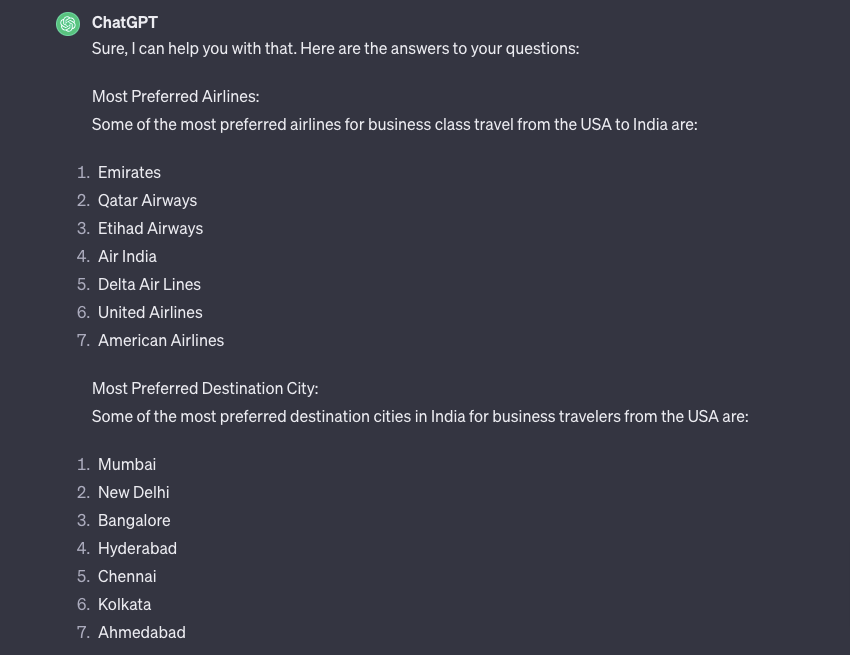
(Source: ChatGPT)
Before fully trusting ChatGPT, Galina cross-checked this information for some countries on Google, which confirmed ChatGPT's accuracy.
She then organized all the collected information into concise tables.
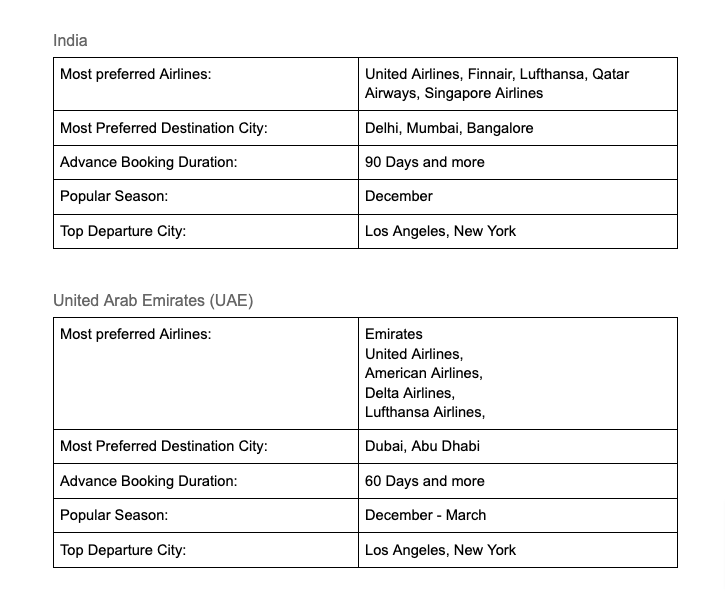
And yes, you can ask ChatGPT to format the outcome in your preferred style.
Results: Manually searching for the most popular towns/villages in each country, the most popular airline, and the best season for not just each country but also each destination (which complicates the search process even further) would have taken two days. However, with ChatGPT, it took Galina only four hours to collect and systemize all these results.
3. Translations and proofreading
ChatGPT is a famous polyglot. :) It speaks more than 100 languages, so you can translate your copy into these languages and proofread it.
Example 1: Translating our newsletters from Ukrainian into English
Stripo is a US-born product made by Ukrainians. This means that English is not our mother tongue, at least for many of us. However, our email newsletters go out in English and Ukrainian, and trigger emails are sent in nine languages. Our email marketer, Oleksander Deieiv, created his amazing newsletters in Ukrainian, and then we translated them into English for him. At least, this is how it worked before ChatGPT.

(Source: ChatGPT)
Important note: When using GenAI (such as ChatGPT), it is crucial to request that no sections of the email be omitted, as this sometimes happens. To prevent this, you could translate paragraph by paragraph; however, you must ensure that the GenAI maintains consistent terminology throughout the email.
We now use ChatGPT in three ways for translation purposes:
- we ask it to translate the texts and then check if we are satisfied with the translations and if they convey the message correctly. We then send these texts to a native speaker for proofreading;
- Oleksander translates his emails with ChatGPT on his own and then has a native speaker proofread them;
- translate emails with ChatGPT alone.
Important note: Currently, we ask a native speaker to proofread the texts to ensure that our emails are written in pure and academically correct language. However, this may only be a temporary measure.
Results: If we go with way 1, the email marketer gets his texts delivered sooner, as we do not need approximately 30 minutes to translate emails, unlike before; it now takes only 10 minutes to translate and check if the email still conveys the right message. If we go with way 2, the email marketer becomes more independent, as he does not need to assign a task to any copywriter (typically done beforehand). He gets his texts done whenever he needs them. Simply put, ChatGPT grants more freedom. Is that not what we all strive for?
Here is another awesome statistics from the agency Language Inspired: Using GenAI translations with human postediting can be up to 70%–80% faster than traditional human translation and editing.
speed increase is achieved when combining GenAI translations with human post-editing compared with traditional human-only methods
By choosing option 3, you can seamlessly translate your email content directly within Stripo or use Google Translate for initial translations and then enhance these translations with ChatGPT, all without leaving Stripo. Simply click the “Launch AI” button to get started.
I am excited to share that we will soon integrate “ChatGPT” into the Stripo Email Translate Service for initial translations. This means that it will autonomously generate emails in all required languages and populate translations in the necessary fields, similar to the current functionality with Google Translate and other vendor translations.
Example 2. Proofreading emails
As mentioned earlier, our trigger emails are sent in nine languages. Yes, we have English- and Ukrainian-speaking proofreaders for whom these languages are native. But what about the other seven languages? We also get our texts translated by a professional agency with native speakers. However, sometimes, we check if the message is conveyed in all languages, if it did not lose the original tone, and so on. Currently, when we get our translations back from the agency, we now check them with ChatGPT.
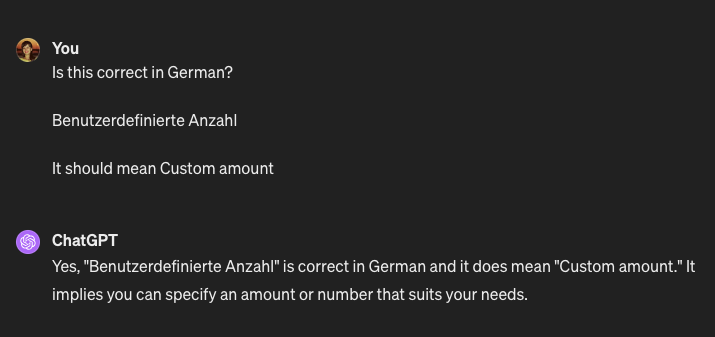
(Source: ChatGPT)
Results: It takes some time, but it is worth it. You are either sure that the messages are exactly what you need them to be, or you have the agency translate them again in accordance with your comments.
Example 3: Last-minute changes
Last-minute changes are pretty common, especially in marketing. Of course, we are not an exception. We had a case when after receiving the translations in all languages, we decided to slightly modify the original message in English and, as a result, in all other languages too.
The changes were minor — we just had to remove a sentence. Yet, we wanted to make sure our emails were correct and that we had removed the necessary sentence in all langugaes, but unfortunately, we did not have time to contact the translation agency again.
Results: Luckily, we did everything right, and our emails were flawless. Yet, thanks to this process, we were not worried about adding these emails to our CDP. And importantly, it did not take much time (less than contacting proofreaders and translators again).
4. Optimizing email content
We can use GenAI here in two ways:
- to check if the tone in our email copy in any language meets the necessary one and optimize it accordingly;
- to optimize our email copy according to our subscribers' age, location, or industry preferences. When you send out back-to-school emails, you need your copy to be easy to understand, appeal to emotions, and so on. When you reach out to developers, you certainly will have to use some professional jargon. GenAI will help you in both cases.
Example: Making email copy easy to perceive
When translating recent email campaigns, we asked ChatGPT if it thinks the email copy would be easy to understand for people who are not among our active users and to remove any service jargon/words a subscriber might not understand.
Here’s what we asked it:
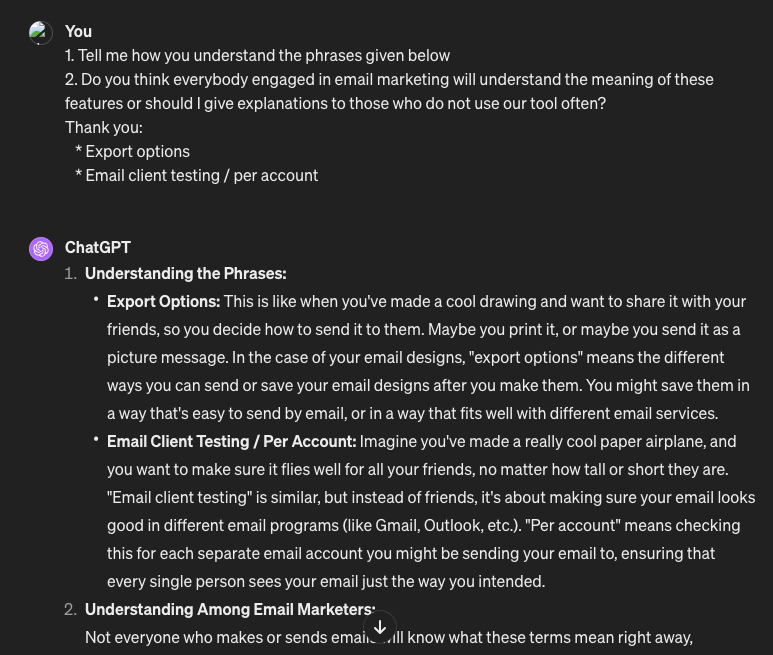
(Source: ChatGPT)
Result: GenAI helped us make our email more suitable for subscribers who do not use our tool often and, as a result, could be confused with some phrases. It made us add explanations to the names of the newly added features so that people actually understand what we are talking about. Of course, you can ask a real editor to do this, which would be great, but using ChatGPT, you:
- get your feedback at any time whenever you need it;
- save yourself some time; and
- check for things a human might oversee.
I believe it is best to run GenAI's responses by a real person (a.k.a. fact-checking). This way, you get your copy checked by both a human and GenAI, which significantly increases the chances that your email messages will be easy for your customers to understand.
5. Making sure your email campaign conveys the necessary message
When translating or composing copy for an email (similar to writing an article), I sometimes want to ensure that my sentences are understandable. You might be familiar with this: when you write something and know what you want to say, you might skip some words, or your sentences might not be logically structured (especially when you are explaining a new feature or want to make your copy as concise as possible, which leads you to eliminate some words).
This is when we turn to ChatGPT for help. I ask it to tell me how it understands my text, focusing on certain phrases. To check if my text is logically structured, I provide it with a scope of copy.
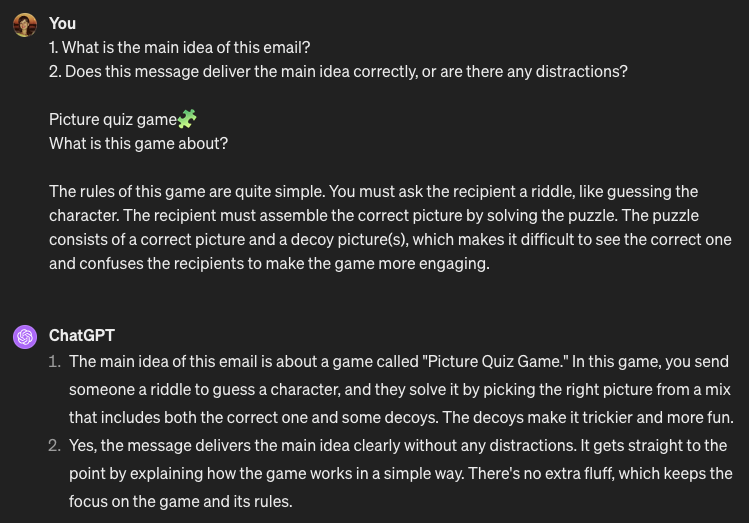
(Source: ChatGPT)
Results: It explains to me exactly how it understands my sentences. If there is any discrepancy between what I want to say and how it understands my copy, I keep modifying it until ChatGPT interprets my copy just as I need people to understand it. Why do I not turn to my colleagues? Because they already know the meaning of these features, and because of professional deformation, they might not spot some clumsy sentences.
6. Verifying customers’ names for correct addressing in any language
It was another surprise for me that we could use ChatGPT for this purpose.
Example 1: Checking the contact base in the language you speak
You like addressing contacts by name, so once in a while, you would rather check the names. You can do it manually, but if your contact base is large, it would take you days to do that.
We decided to check the names of recipients who set English and Ukrainian as their preferred languages.
You can ask GenAI to check the names and highlight those that are incorrect or nonexistent (some email marketers claim that they have “Unicorns” in their contact base) and replace them with something like “Your Company Name Enthusiast” or “Fashion Lovers.” Essentially, you ask it to fix typos (“Hannna” to “Hanna”).
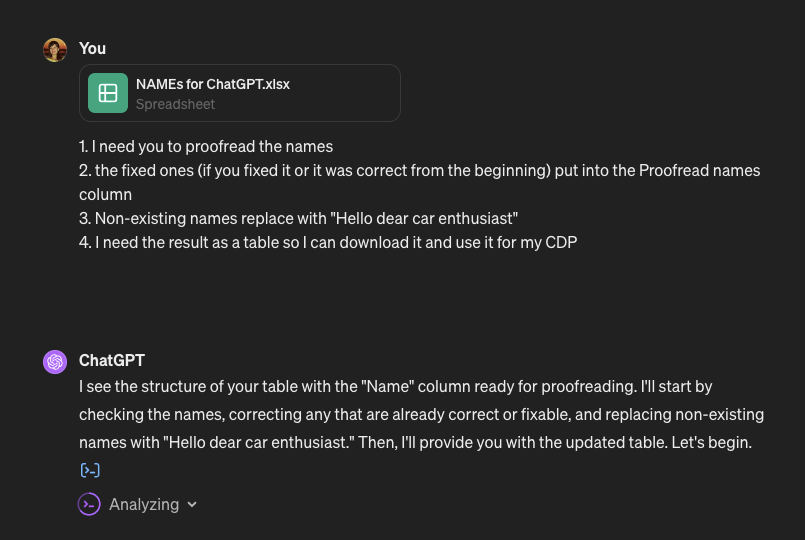
(Source: ChatGPT)
You can upload your base as an Excel file for your convenience.
Results: We cannot really say how much time it would have taken us to verify the names of our contacts manually. We have more than 100,000 subscribers, so it is safe to say that it would have taken a few days at least.
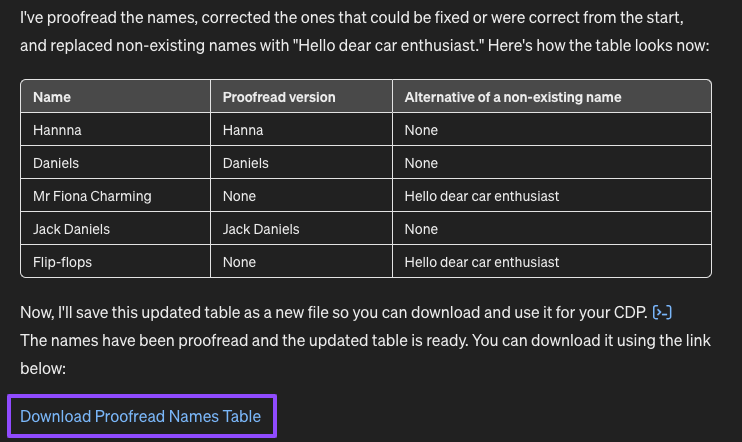
(Source: ChatGPT)
As you can see, ChatGPT shows me the results right away and allows me to download the table and import it to my CDP later.
Example 2: Checking the contact base in the language you do not speak
We run our email marketing in nine languages, while we speak only a few of them. So we are now planning to check our contacts' names in other languages through ChatGPT.
We will go the same way as we did for our English and Ukrainian subscribers: upload a contact base for each language separately.
Results: None of us spoke German, so if it were not for ChatGPT, we would have had to hire a native speaker. But who knows how much money it could have cost us and how much time it could have taken.
Wrapping up
Localizing emails can be challenging with traditional methods such as Google Translate or human translators due to time, cost, improper localization, and lost context. In this article, we explored how GenAI, which we have tested extensively, offers solutions to these challenges.
Key insights:
- Cultural sensitivity: Traditional localization methods often fail to account for the nuances of customs and traditions, leading to irrelevant content for specific audiences. However, GenAI can tailor translations to respect cultural specifics such as holidays and idioms, ensuring relevance. A useful tip is to incorporate a checklist into your GenAI prompts to verify cultural appropriateness.
- Content customization: For multilingual campaigns, GenAI can adapt content for each language, taking into account local customs and relevance. Adding custom instructions and a brand-specific glossary for each language individually enhances this process. Specifying target countries for each language version enables GenAI to optimize content and identify potential irrelevancies.
Future updates will enable these functionalities directly within Stripo, further easing the localization process.
Our experience and examples show that GenAI not only respects cultural nuances but also significantly boosts efficiency in multilingual email marketing, marking a transformative step in global communication strategies.






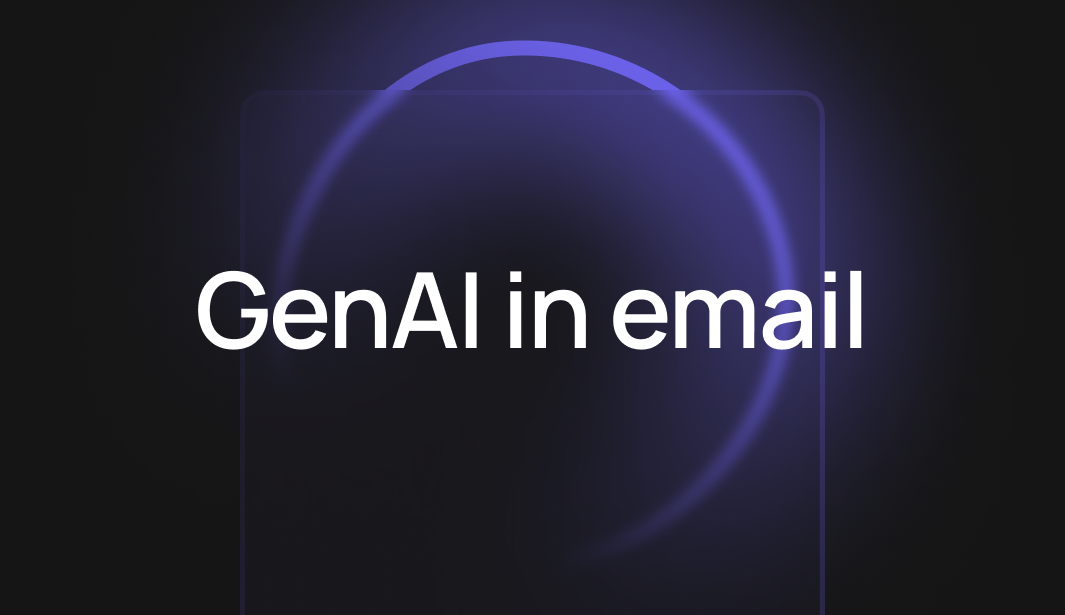


0 comments